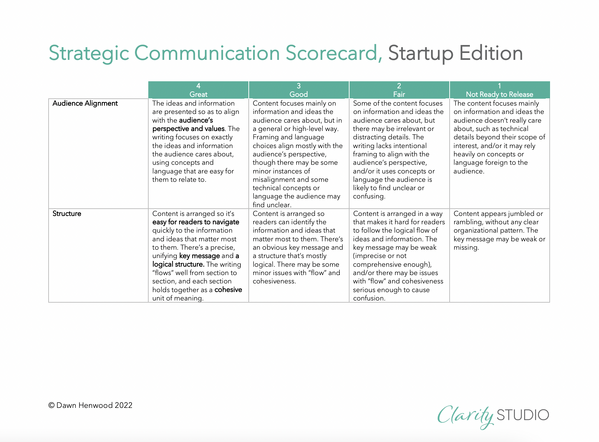
A few years ago, a former academic colleague and I were reminiscing about another colleague, who was a mentor to me during my first year of teaching.
Reflecting on our different journeys as writing teachers, Colleague #1 said of Colleague #2, “She always seemed to me rather obsessed with assessment.”
Peacemaker that I am, I smiled at this comment–but internally I did a mental fist pump.
“You’re darn right!” I thought to myself. “If there’s one thing a writing instructor should be obsessed with, it’s assessment.”
In my coaching practice, I’d say that assessment constitutes three-quarters of what I do. Certainly, it’s the most valuable part of the support I give clients.
At least that’s what they tell me, after they’ve gotten over the initial surprise at the kind of feedback I provide.
How communication coaching really works
People tend to assume that a communication coach will act as an upscale writing tutor. Perhaps remembering all those red-lined essays or lab reports from their university days, they expect that I’ll point out everything that’s “wrong” in a message or document and tell them how to “fix” it.
But I never “correct” a piece of written communication, unless the client has explicitly asked me to edit their work. Instead, as any coach does, I ask a lot of questions. These create a path of inquiry that enables the client and I to collaborate on assessing the strengths and weaknesses of a draft.
Only once you’ve accurately assessed a communication product can you hope to do anything about improving it.
Like anyone using a “coach approach,” I assume that the client already holds the answers to the questions I raise. But those answers may be locked behind undeveloped thinking, false assumptions, or shallow confidence.
Questions provide both the path to the door and the key that opens it.

Simple questions, complex answers
Some of the questions I ask sound basic, at first. Yet it’s the simple, obvious questions that demand the most critical thinking. These are the queries that lay the foundation for a solid assessment framework. We need them to flesh out the specific criteria against which the communication product should be measured.
For instance, I always begin a coaching engagement with two questions that sound super-simple but often lead to intense conversations about branding, positioning, and marketing strategy:
- Who is your audience?
- What is your communication goal?
Most clients can readily identify their audience in terms of their demographic profile (e.g., women of color under 40) or their technical needs (e.g., organizations that need a multilingual project management tool). But that’s just the starting point.
From there, the question becomes “Who is your audience, really?” And that opens a whole series of questions that allow us to explore the outer and inner world of the target audience.
If you don’t know who your audience is, really, then any assessment of your messaging to them will be off-kilter.
At the end of the day, we measure the success of a communication product by its effect on the audience. If you haven’t taken the time to fully envision your audience, as complete human beings, how can you even try to imagine the impact your words and visuals will have on them?
Without probing the depths of audience analysis, it’s also impossible to answer the second, also deceptively simple, question: “What’s your communication goal?”
When you’re a big, bold thinker (like most of my clients), it can be easy to overreach on the goal for a single communication product. For example, a founder might write an email introducing their company to a stranger, with the goal of landing a sale.
That’s just not realistic, and accurate assessment requires realism. In the case of an introductory email, a realistic goal might be for the recipient to click on a link or to visit a webpage or schedule a short conversation. Once we’ve identified an achievable outcome, then–through more questioning–we can articulate what the communication will need to do to meet that objective.
Putting performance first
As my assessment-obsessed mentor taught me years ago, the key to accurately appraising a communication product is to focus on performance. Not content, or ideas, or intent, but the effectiveness with which the words and visuals function in relation to achieving the communication goal.
When you view communication through a performance lens, many common, unhelpful obsessions fall away.
Word count, for example, becomes a secondary or tertiary concern. The goal is never to generate a certain number of characters; it’s to use the available characters to lead the audience to a certain outcome.
An unhealthy preoccupation with “rules” of grammar and punctuation also recedes. The goal is never correctness or even (dare I say it) clarity–it’s a practical result.
This outcomes orientation can feel disorienting if you’ve cut your communication teeth on creating academic articles and presentations. In a scholarly context, communication aims to analyze a subject whereas in a business context, the goal is to persuade the audience.
In some situations, persuasion might mean changing the audience’s perspective on a topic, but more often, it means convincing them to take a specific action. You want them to click that link, approve that funding request, book that meeting, or adopt your recommended solution.
Once you make the mental shift to communication outcomes, however, you’re well on your way to creating a valid, reliable assessment framework.[1] When you recognize what a communication product must do, then you can establish criteria to judge its performance. Then, it’s simply a matter of rating the draft against each of those requirements.

Assessment skills pave the way to confidence
Clients often come to me for coaching because they want “fresh eyes” on a communication product they’ve been working on for a while, such as a business plan, a pitch deck, a batch of web copy, or a consulting report.
While I do provide an outside perspective, by guiding the client through a careful assessment process, I mainly empower them to view their own work as objectively as possible.
This ability to gain critical distance on your own creative products–to view the performance from the audience’s perspective–can turn reluctant creators into fluent creators. Time and again, I’ve seen that developing skills in self-assessment boosts both productivity and self-assurance.
Knowing what “good enough” looks like prevents perfectionism from sabotaging your efforts and develops the confidence you need to say, “Just press Send!”
Thanks to the obsession with assessment that my mentor passed on to me, I enable clients to become their own writing coach.
I know I’ve succeeded when a client starts bringing their own questions to the discussion of a draft, or when they start tweaking tools I’ve provided to make them their own. At that point, they’ve become shrewd assessors not just of their communication products but also of the process they use to create them.
As you work on messages, documents, and presentations to drive your business forward, you might want to experiment with an assessment tool from one of our group programs. Just click the thumbnail below to download a copy of the Strategic Communication Scorecard, Startup Edition.
[1] In the lingo of performance-based assessment, an assessment tool is considered valid if it enables the user to accurately rate performance. An assessment tool is considered reliable if different raters can use it to arrive at the same assessment.



Comments